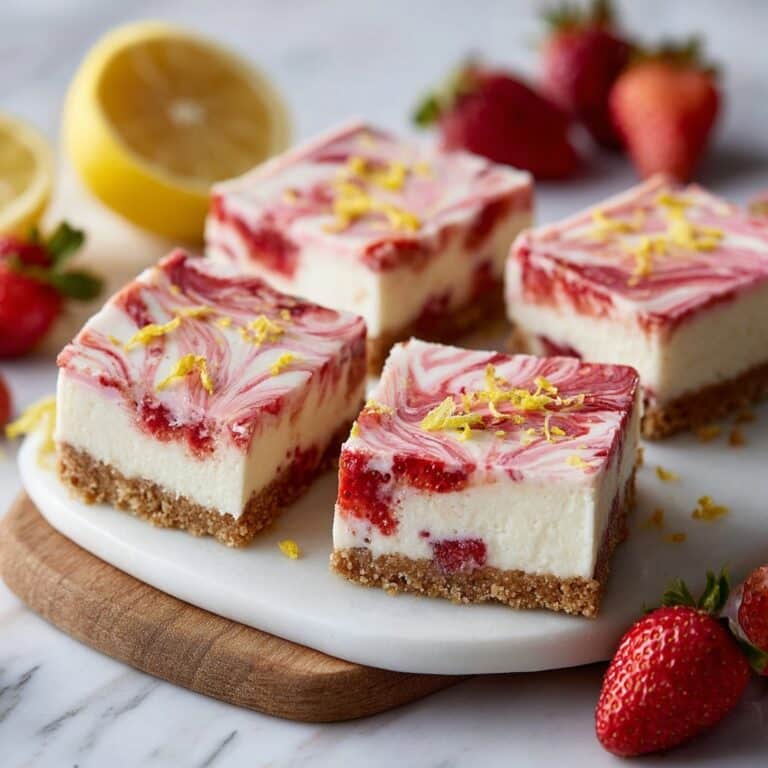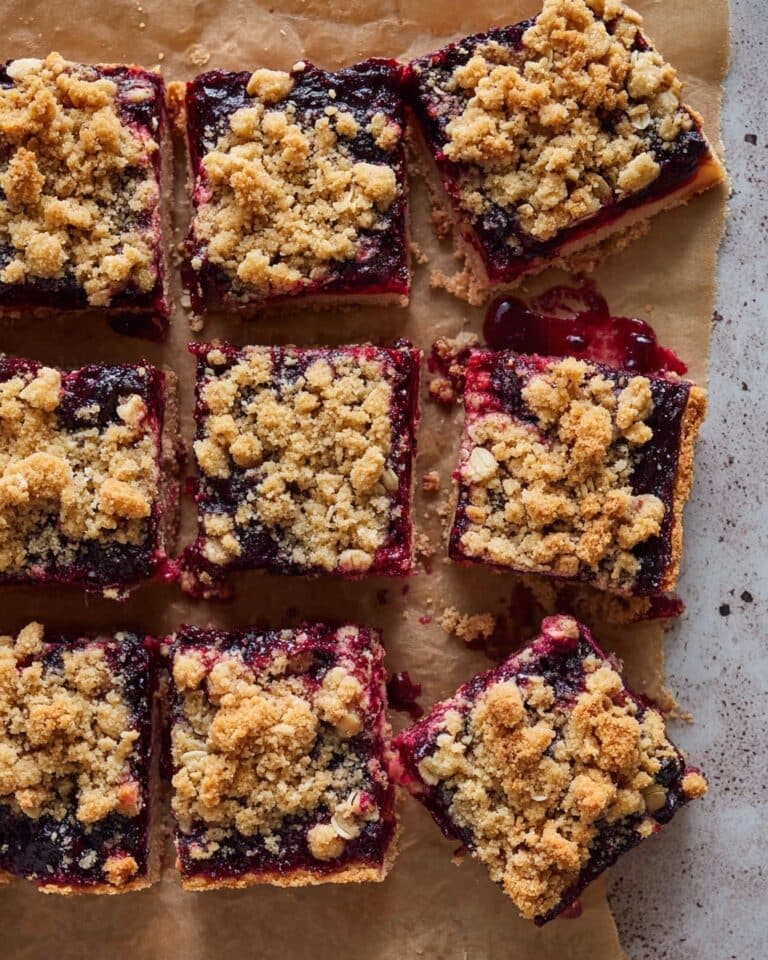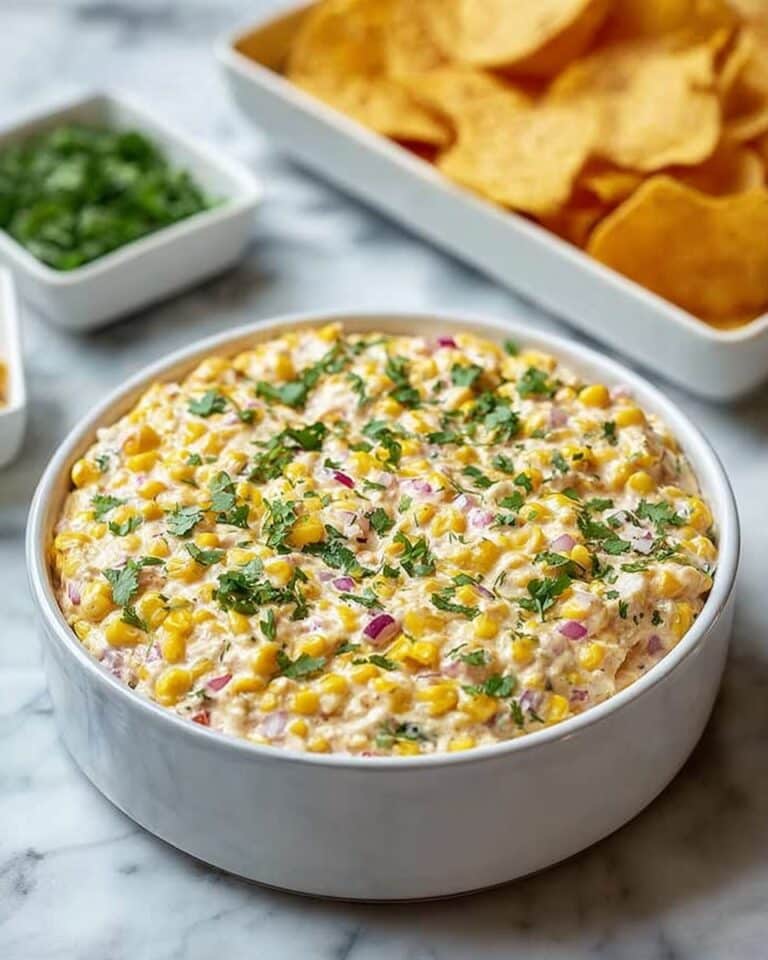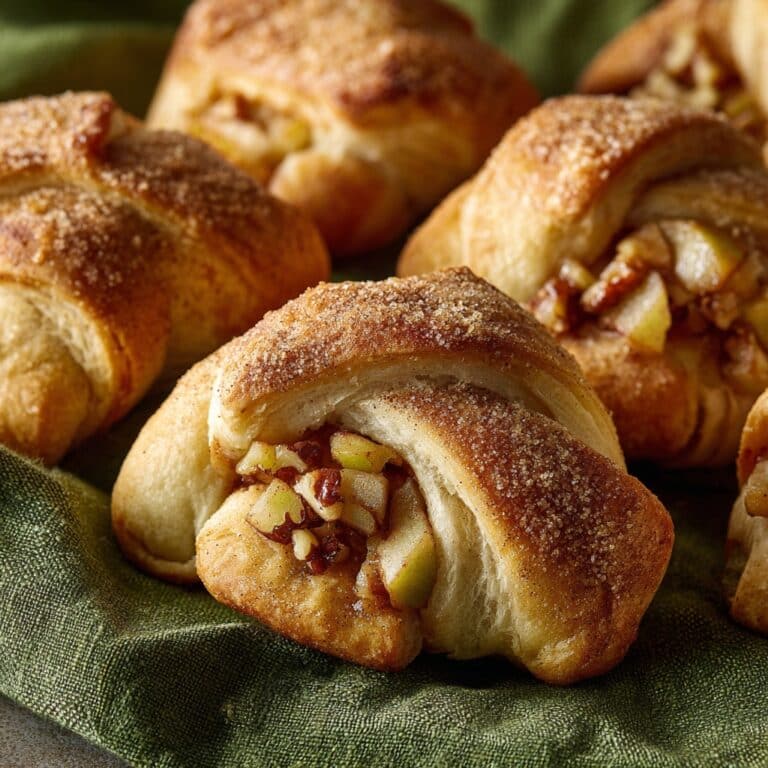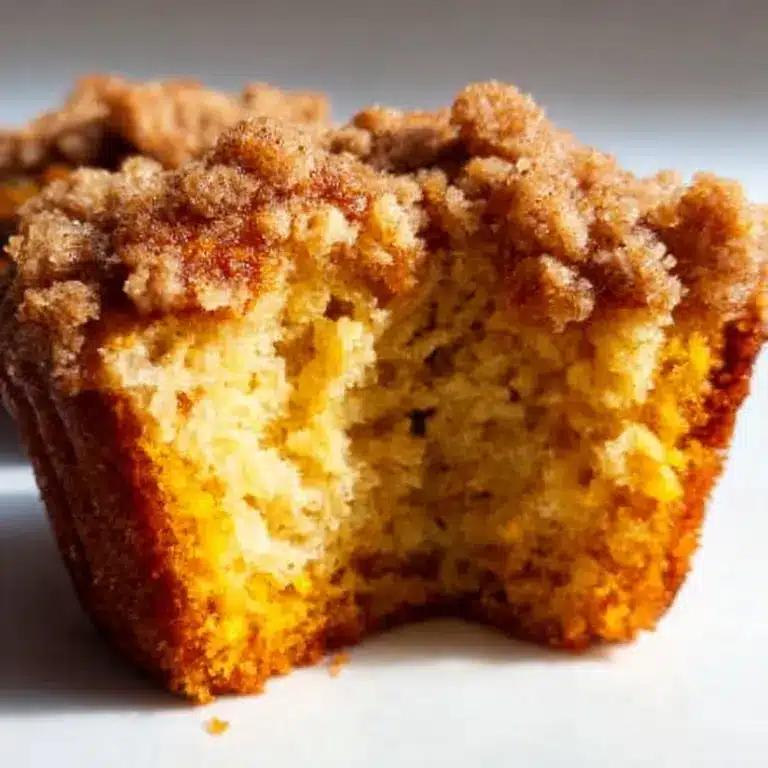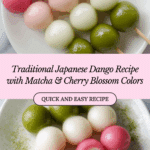Easy Dango Recipe
If you have a sweet tooth and a soft spot for traditional Japanese treats, you’re going to love this Easy Dango Recipe. These delightful, colorful rice dumplings are chewy, subtly sweet, and bursting with nostalgia. Making dango at home might sound intimidating, but this recipe breaks it down into simple steps that guarantee perfect results every time. Whether you’re looking to enjoy them as a snack or impress friends with a charming dessert, dango is a charming and tasty choice that’s both fun to make and eat.
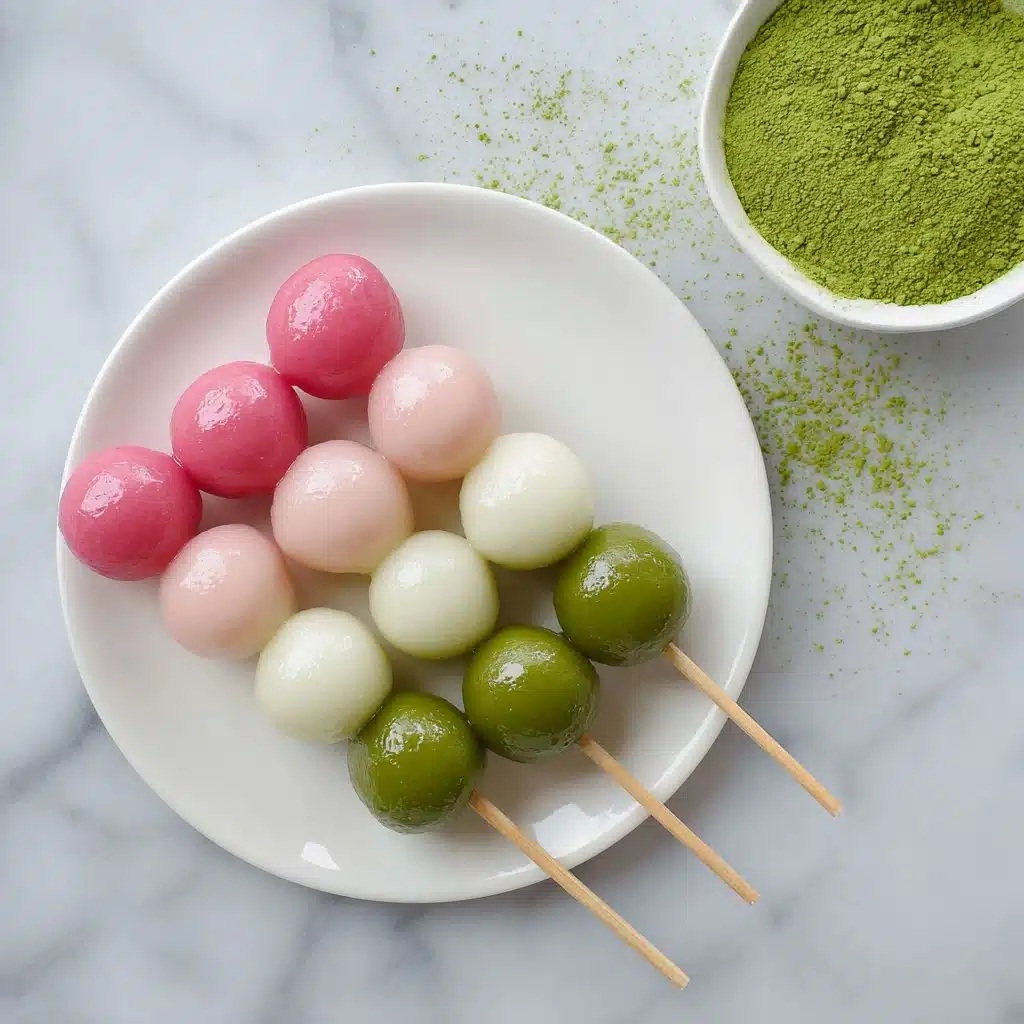
Ingredients You’ll Need
The ingredients for this Easy Dango Recipe are straightforward, each adding a unique role in creating the perfect texture, flavor, and vibrant colors. You’ll need just a couple of types of rice flour, some optional sweetness, and a few natural colorings to make these dumplings come alive.
- Joshinko non-glutinous rice flour: A great base that balances texture without being too sticky.
- Shiratamako glutinous sweet rice flour: Gives the dango its signature chewy and tender bite.
- Powdered sugar (optional): Adds a gentle sweetness, but you can always skip it for a more neutral flavor.
- Hot water: Helps bring the dough together smoothly for kneading.
- Matcha powder: Brings an earthy green hue and subtle bitterness that contrasts beautifully with the sweet dough.
- Pink food coloring: Just a drop introduces a lovely, festive pop of color representing cherry blossoms.
- Bamboo skewers: Essential for assembling these bite-sized treats, soaking them first prevents burning.
How to Make Easy Dango Recipe
Step 1: Prepare Your Tools
Before mixing dough, soak 12 small bamboo skewers in water so they don’t burn later when the dango are cooked and ready to be served.
Step 2: Mix the Flours and Sugar
Combine 150 grams of joshinko non-glutinous rice flour with 200 grams of shiratamako glutinous sweet rice flour in a bowl. If you love your dango on the sweeter side, now’s the time to add about 75 grams of powdered sugar for that delicate sweet touch.
Step 3: Add Hot Water and Knead
Pour in 1 1/3 cup of hot water and start mixing with a spoon. When the dough begins to come together, switch to your hands to knead it thoroughly. Adjust with a little more flour or water so the dough feels like soft clay—pliable but not sticky.
Step 4: Divide and Color the Dough
Separate the dough evenly into three portions and place these into separate bowls. Add a single drop of pink food coloring to one bowl, mixing it gently into the dough.
Step 5: Prepare and Add Matcha Paste
Mix 1 teaspoon of matcha powder with 1 teaspoon of water to form a smooth paste. Incorporate this paste into the second bowl of dough to give it a lovely green tint and earthy flavor.
Step 6: Leave the Last Dough White
The third portion of dough will remain plain white, giving your dango that classic trio of pastel hues that is both pretty and traditional.
Step 7: Shape the Dumplings
Using a kitchen scale, portion out 20 grams of dough for each ball. Roll each piece into smooth, round dumplings. This recipe yields about 36 round balls, perfect for serving on skewers.
Step 8: Boil the Dango in Color Order
Bring a pot of water to a boil and start cooking the white dango first. When the balls float to the surface, continue boiling them for another two minutes. Transfer them immediately to a bowl of ice water to set their texture.
Step 9: Repeat for Pink and Green
Repeat the boiling and cooling process for the pink dango next, then the green last. Cooking in this order helps keep the water clear and prevents the colors from bleeding into each other.
Step 10: Skewer Your Dango
Assemble the skewers by sliding on the green dumplings first, white in the middle, and pink last. This color order reflects the symbolism of Japanese seasons, evoking the hues of grass, snow, and cherry blossoms.
How to Serve Easy Dango Recipe
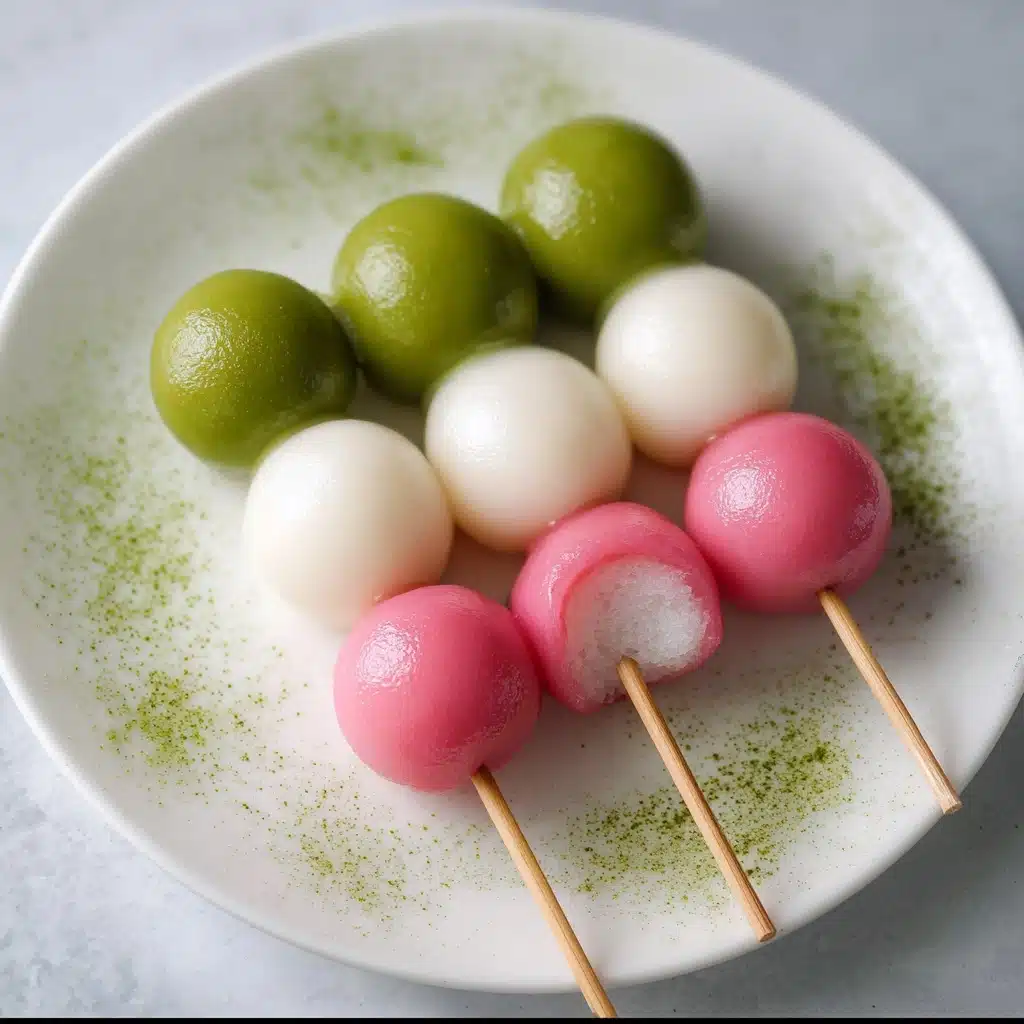
Garnishes
To elevate your Easy Dango Recipe, try drizzling the skewers with sweet soy glaze for a glossy, savory finish. Alternatively, a smear of red bean paste or a sprinkle of matcha powder enhances flavor with traditional Japanese touches. Even a dusting of kinako (roasted soybean flour) can add a nutty depth that’s simply irresistible.
Side Dishes
Dango pairs wonderfully with a cup of hot green tea or a chilled matcha latte for a refreshing contrast. You might also serve it alongside fruits like fresh strawberries or citrus segments to balance the chewiness with bright, juicy notes. For a more savory contrast, try a small bowl of miso soup.
Creative Ways to Present
Get creative by arranging your dango skewers in a decorative platter with edible flowers for a seasonal touch. You could also embed them into a visually striking dessert board featuring mochi, sweet beans, and fresh fruits. Another fun presentation is serving them individually on small plates with different dipping sauces for guests to mix and match flavors.
Make Ahead and Storage
Storing Leftovers
If you have leftover dango, store them in an airtight container in the refrigerator for up to 2 days. Because of their delicate texture, it’s best to consume them soon after making for maximum softness and flavor.
Freezing
Freezing is not ideal for dango as it can change their chewy texture, making them harder and less pleasant to eat. If you must freeze, place them on a tray first and freeze individually before storing in a freezer bag, and consume within one month.
Reheating
To reheat refrigerated dango, gently steam them for a few minutes until warm and soft again. Avoid microwaving as it may dry them out or make them tough. Serving them freshly cooked is always best to enjoy their perfect chewiness.
FAQs
What is the difference between joshinko and shiratamako?
Joshinko is a non-glutinous rice flour that provides structure without stickiness, while shiratamako is glutinous rice flour that gives dango their chewy, soft texture. Combining the two balances chewiness with firmness perfectly.
Can I make dango without food coloring?
Absolutely! The colors add visual charm and symbolism, but if you prefer, you can keep all the dough plain white or flavor them naturally with matcha or other flavorings for color.
What can I use instead of bamboo skewers?
If you don’t have bamboo skewers, small wooden toothpicks or metal skewers can work, but bamboo is traditional and best for its size and heat resistance, especially after soaking in water.
How long do dango stay fresh?
Dango are best enjoyed the day they are made, but you can store leftovers in the fridge and eat within 2 days for good texture and flavor.
Is powdered sugar necessary in this Easy Dango Recipe?
No, powdered sugar is optional and mostly for added sweetness. Traditional dango can be less sweet and paired with flavorful toppings to balance the taste.
Final Thoughts
This Easy Dango Recipe brings a little piece of Japanese tradition into your kitchen in a fun and approachable way. I encourage you to give these chewy, colorful dumplings a try—you’ll find that the process is simple, the ingredients are accessible, and the results are utterly delicious. Whether enjoyed plain or garnished, dango makes for a charming snack that’s sure to become a favorite for you and anyone you share them with.
Print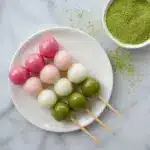
Easy Dango Recipe
- Total Time: 35 minutes
- Yield: 12 skewers (36 dango balls) 1x
- Diet: Vegetarian
Description
This Easy Dango Recipe creates colorful and chewy Japanese rice flour dumplings perfect for spring celebrations or any time you want a delightful sweet snack. With three vibrant colors—pink, white, and green—symbolizing the seasons, these bite-sized treats are simple to make using both non-glutinous and glutinous rice flours, flavored naturally with matcha and a touch of food coloring. Enjoy dango skewered traditionally or with your favorite toppings like sweet soy glaze or red bean paste.
Ingredients
Dango Dough
- 1 1/3 cup Joshinko non-glutinous rice flour (150 g)
- 1 1/2 cup Shiratamako glutinous sweet rice flour (200 g)
- 3/4 cup powdered sugar (optional, 75 g)
- 1 1/3 cup hot water
Coloring & Flavoring
- 1 teaspoon matcha powder
- 1 teaspoon water (for matcha paste)
- 1 drop pink food coloring
Additional
- 12 small bamboo skewers, soaked in water before use
Instructions
- Prepare Skewers: Soak 12 small bamboo skewers in water to prevent burning during cooking.
- Mix Flours and Sugar: In a bowl, combine 150 g non-glutinous rice flour (Joshinko) with 200 g glutinous sweet rice flour (Shiratamako) and optional 75 g powdered sugar for sweetness.
- Add Hot Water and Form Dough: Pour in 1 1/3 cup hot water, stirring with a spoon until mixture starts to come together. Use hands to knead dough into a clay-like consistency, adjusting with more flour or water as needed for softness.
- Divide Dough: Split dough evenly into three portions and place each in separate bowls.
- Color Pink Dough: Add one drop of pink food coloring to one portion and knead evenly to distribute color.
- Make Matcha Paste and Color Green Dough: Mix 1 teaspoon matcha powder with 1 teaspoon water to create paste, then knead it into the second dough portion.
- Leave Third Dough White: Keep the third portion plain white without additions.
- Shape Dango Balls: Using a kitchen scale, portion the dough into 20-gram balls, shaping each into a smooth round ball. This recipe yields about 36 balls total.
- Boil White Dango: Bring a pot of water to a boil. Gently add white dango balls. When they float, cook for an additional 2 minutes.
- Cool in Ice Water: Use a slotted spoon to transfer boiled dango to a bowl of ice water to stop cooking and set texture.
- Repeat Boiling & Cooling for Pink and Green Dango: Boil and cool pink dango next, then green last to prevent color bleeding.
- Skewer Dango: Thread 3 dango balls per skewer, placing green first, white in the middle, and pink last. This traditional order represents seasonal colors: green for grass, white for winter snow, and pink for spring cherry blossoms.
- Serve: Enjoy dango plain or with toppings such as sweet soy glaze, red bean paste, or matcha paste according to preference.
Notes
- Use precise measurements of flour and water for correct dough consistency—similar to soft clay.
- Adding powdered sugar is optional, adjust sweetness to taste.
- Cook dango in order of white, pink, then green to prevent color contamination.
- Soaking skewers before grilling or serving helps prevent burning.
- Dango is best enjoyed fresh but can be refrigerated and gently reheated.
- Alternative toppings include kinako (roasted soybean flour) or sweetened condensed milk.
- Prep Time: 20 minutes
- Cook Time: 15 minutes
- Category: Dessert
- Method: Boiling
- Cuisine: Japanese
Nutrition
- Serving Size: 3 dango balls (1 skewer)
- Calories: 110 kcal
- Sugar: 8 g
- Sodium: 5 mg
- Fat: 0.2 g
- Saturated Fat: 0 g
- Unsaturated Fat: 0.1 g
- Trans Fat: 0 g
- Carbohydrates: 26 g
- Fiber: 0.5 g
- Protein: 1.5 g
- Cholesterol: 0 mg
Keywords: Dango, Japanese dessert, rice flour dumplings, matcha dango, colorful dango, easy dango recipe, traditional Japanese sweets

